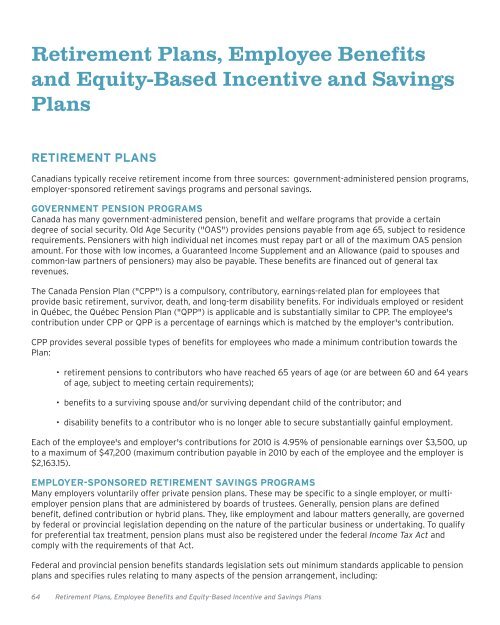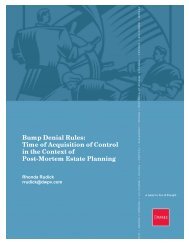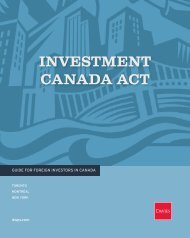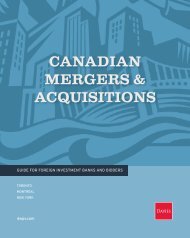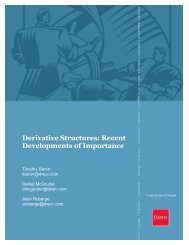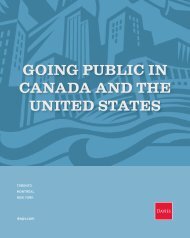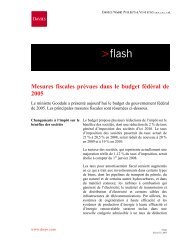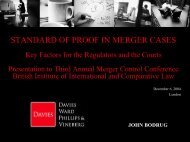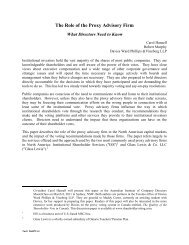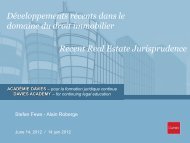doing business in canada - Davies Ward Phillips & Vineberg LLP
doing business in canada - Davies Ward Phillips & Vineberg LLP
doing business in canada - Davies Ward Phillips & Vineberg LLP
- No tags were found...
You also want an ePaper? Increase the reach of your titles
YUMPU automatically turns print PDFs into web optimized ePapers that Google loves.
Retirement Plans, Employee Benefitsand Equity-Based Incentive and Sav<strong>in</strong>gsPlansRETIREMENT PLANSCanadians typically receive retirement <strong>in</strong>come from three sources: government-adm<strong>in</strong>istered pension programs,employer-sponsored retirement sav<strong>in</strong>gs programs and personal sav<strong>in</strong>gs.GOVERNMENT PENSION PROGRAMSCanada has many government-adm<strong>in</strong>istered pension, benefit and welfare programs that provide a certa<strong>in</strong>degree of social security. Old Age Security ("OAS") provides pensions payable from age 65, subject to residencerequirements. Pensioners with high <strong>in</strong>dividual net <strong>in</strong>comes must repay part or all of the maximum OAS pensionamount. For those with low <strong>in</strong>comes, a Guaranteed Income Supplement and an Allowance (paid to spouses andcommon-law partners of pensioners) may also be payable. These benefits are f<strong>in</strong>anced out of general taxrevenues.The Canada Pension Plan ("CPP") is a compulsory, contributory, earn<strong>in</strong>gs-related plan for employees thatprovide basic retirement, survivor, death, and long-term disability benefits. For <strong>in</strong>dividuals employed or resident<strong>in</strong> Québec, the Québec Pension Plan ("QPP") is applicable and is substantially similar to CPP. The employee'scontribution under CPP or QPP is a percentage of earn<strong>in</strong>gs which is matched by the employer's contribution.CPP provides several possible types of benefits for employees who made a m<strong>in</strong>imum contribution towards thePlan:• retirement pensions to contributors who have reached 65 years of age (or are between 60 and 64 yearsof age, subject to meet<strong>in</strong>g certa<strong>in</strong> requirements);• benefits to a surviv<strong>in</strong>g spouse and/or surviv<strong>in</strong>g dependant child of the contributor; and• disability benefits to a contributor who is no longer able to secure substantially ga<strong>in</strong>ful employment.Each of the employee's and employer's contributions for 2010 is 4.95% of pensionable earn<strong>in</strong>gs over $3,500, upto a maximum of $47,200 (maximum contribution payable <strong>in</strong> 2010 by each of the employee and the employer is$2,163.15).EMPLOYER-SPONSORED RETIREMENT SAVINGS PROGRAMSMany employers voluntarily offer private pension plans. These may be specific to a s<strong>in</strong>gle employer, or multiemployerpension plans that are adm<strong>in</strong>istered by boards of trustees. Generally, pension plans are def<strong>in</strong>edbenefit, def<strong>in</strong>ed contribution or hybrid plans. They, like employment and labour matters generally, are governedby federal or prov<strong>in</strong>cial legislation depend<strong>in</strong>g on the nature of the particular <strong>bus<strong>in</strong>ess</strong> or undertak<strong>in</strong>g. To qualifyfor preferential tax treatment, pension plans must also be registered under the federal Income Tax Act andcomply with the requirements of that Act.Federal and prov<strong>in</strong>cial pension benefits standards legislation sets out m<strong>in</strong>imum standards applicable to pensionplans and specifies rules relat<strong>in</strong>g to many aspects of the pension arrangement, <strong>in</strong>clud<strong>in</strong>g:64 Retirement Plans, Employee Benefits and Equity-Based Incentive and Sav<strong>in</strong>gs Plans


